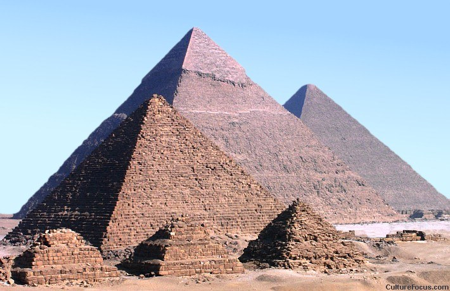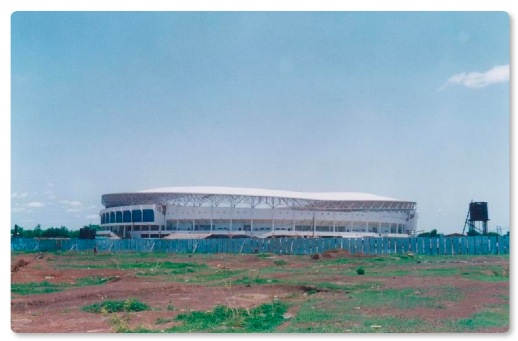« 2008 October | Main | 2008 June »
Sunday, July 13, 2008
The Pyramids and How They Were Built.
Monday, July 07, 2008
Tamale Stadium
The Pyramids and How They Were Built.

Okay, I've been bugged by a silly question for
some years now and I don't know the answer to
it.
If you read most any book about the Pyramids of Giza and how they were built you'll get any number of theories of how they dragged those blocks of granite to the top of the heap as it was being built. There is any number of theories and there is evidence that there was a ramp or causeway leading from a canal to the pyramids themselves. That's all well and good. I don't have much problem imagining how they could manually drag even the largest of blocks up a ramp.
But what they never seem to explain is how the heck did they get these massive stones on and off of a boat? No one has explained it yet that I've seen. To me, this is a much more difficult question to answer than simply dragging the stone along the ground. On a boat you have to lift the stone over the gunwhale, lower it onto a boat large enough to displace more water than the weight of these stones, and have enough structure in the boat to support this concentrated weight.
I don't know what kind of boat the Egyptians had four thousand years ago that could hold that much tonnage, but I imagine that they had such a boat, for holding grain or wine jugs, etc. What I don't understand is how they could move this stone onto the boat without crushing it, swamping it, or toppling it over.
And even more crazy, once it was on the boat, how did they get it back out again?
If you read most any book about the Pyramids of Giza and how they were built you'll get any number of theories of how they dragged those blocks of granite to the top of the heap as it was being built. There is any number of theories and there is evidence that there was a ramp or causeway leading from a canal to the pyramids themselves. That's all well and good. I don't have much problem imagining how they could manually drag even the largest of blocks up a ramp.
But what they never seem to explain is how the heck did they get these massive stones on and off of a boat? No one has explained it yet that I've seen. To me, this is a much more difficult question to answer than simply dragging the stone along the ground. On a boat you have to lift the stone over the gunwhale, lower it onto a boat large enough to displace more water than the weight of these stones, and have enough structure in the boat to support this concentrated weight.
I don't know what kind of boat the Egyptians had four thousand years ago that could hold that much tonnage, but I imagine that they had such a boat, for holding grain or wine jugs, etc. What I don't understand is how they could move this stone onto the boat without crushing it, swamping it, or toppling it over.
And even more crazy, once it was on the boat, how did they get it back out again?
I don't have any educated theories to offer, I'm
not one who can claim any expertise in the matter. I imagine that they might
have built the boat around the stone and then flooded the area around the boat
to float it. At the destination they could run aground and dismantle the boat
again.
But here's my question. If you could get a stone onto a boat and float it with relative ease to any place with water, why wouldn't you keep that stone in the boat as long as you could? Why remove it from the boat when still a few miles from the pyramids? Or even a few feet? I'd be running that canal right to the inch of where I needed it.
In fact, if I could get it on a boat and could move it anywhere there was water, I'd be sorely tempted to lift the stone in its place using the boat. It can't be that hard to build a series of locks to lift the stone all the way to the top of the pyramid. The locks could even be moving. That is, imagine a ramp in place that rises to the necessary level of construction: couldn't you have three locks always in place? One for where the stone just left, one for where it is, and one for the next level. Once it moves to the middle level they dismantle the lower lock and move it above the third lock.
I would think it's a lot easier to move an empty lock and pump water into it than it is to drag a stone up a ramp so dangerously. If I were there and already knew how to put a stone that large into a boat, that would surely be my method of lifting it to where it needed to be. And if it's at the level needed, why not release the water and lower the stone onto the exact position at the same time. I mean, if it's already floating, why not use that in your favor to the utmost?
But I still just can't understand how they got the stones into the boats.
Addendum 14 July, 2008: I found an explanation of how the stones were transported by boat. I still think it makes sense to use locks to lift them to their final height.
But here's my question. If you could get a stone onto a boat and float it with relative ease to any place with water, why wouldn't you keep that stone in the boat as long as you could? Why remove it from the boat when still a few miles from the pyramids? Or even a few feet? I'd be running that canal right to the inch of where I needed it.
In fact, if I could get it on a boat and could move it anywhere there was water, I'd be sorely tempted to lift the stone in its place using the boat. It can't be that hard to build a series of locks to lift the stone all the way to the top of the pyramid. The locks could even be moving. That is, imagine a ramp in place that rises to the necessary level of construction: couldn't you have three locks always in place? One for where the stone just left, one for where it is, and one for the next level. Once it moves to the middle level they dismantle the lower lock and move it above the third lock.
I would think it's a lot easier to move an empty lock and pump water into it than it is to drag a stone up a ramp so dangerously. If I were there and already knew how to put a stone that large into a boat, that would surely be my method of lifting it to where it needed to be. And if it's at the level needed, why not release the water and lower the stone onto the exact position at the same time. I mean, if it's already floating, why not use that in your favor to the utmost?
But I still just can't understand how they got the stones into the boats.
Addendum 14 July, 2008: I found an explanation of how the stones were transported by boat. I still think it makes sense to use locks to lift them to their final height.
Monday, July 07, 2008
Tamale Stadium
Just a few miles from the world's most extreme
type of poverty is the Tamale stadium. Here's a few pictures of
it:



This last picture appears to have been taken while it was under construction, but it's a pretty accurate depiction of how it appears now. The construction fence has been replaced by a more permanent fence. At least one gate was hanging by only one hinge when I saw it, which affirmed that we were indeed still in Ghana. Otherwise, it's a beautiful building.



This last picture appears to have been taken while it was under construction, but it's a pretty accurate depiction of how it appears now. The construction fence has been replaced by a more permanent fence. At least one gate was hanging by only one hinge when I saw it, which affirmed that we were indeed still in Ghana. Otherwise, it's a beautiful building.
I'm told the place is regularly filled to
capacity. Ghanaians love their football.
